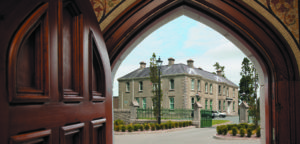THE POPE IN IRELAND
MEMORIES AND REFLECTIONS:
25 YEARS ON
BY CARDINAL CAHAL B DALY
[For the ‘Irish Catholic’]
My memories of Pope John Paul’s pastoral visit to Ireland 25 years ago are still very fresh. I spent most of that September working in Rome with the group which prepared drafts of the Holy Father’s addresses. The group was composed mainly of priests working in the Holy See’s Secretariat of State. Since the Holy Father was proceeding directly from Ireland to the ‘United Nations’ Assembly in the United States, there were two sets of texts to be prepared together, with some 60 addresses in all to be delivered.
The first and the final version of each address came from the Pope himself. He wrote a preliminary draft for each address, read and revised each subsequent version personally, and made the final text his own. I remember his insistence that his Irish addresses, and particularly the address in Drogheda, should be direct and specific. The Drogheda address is in fact the one to which he delivered particular and personal attention. It was clear that he was closely informed about the conflict then raging in Ireland, that he was fully aware of its complex underlying causes, and that he saw the need for political and economic responses to the violence. He was strongly convinced of the moral wrongness and futility, both of recourse to violence and of such forms of excessive military response to violence as violated justice and human rights.
I was struck by the long working hours of the priests who cheerfully worked all through the days and often far into the nights at their drafting and redrafting task. I often wondered what they did for sleep. But it was the Pope’s own activity which impressed me most. Once a week, and sometimes more often, during the weeks of preparation, there was a working lunch at which the Pope discussed the various drafts in turn and asked for amendments. His energy, physical as well as mental, was phenomenal. When one looks at photographs or at recorded television coverage of the 1979 visit, and compares these with the television images of the visit to Lourdes last month, the contrast is startling between the dynamic, athletic stride and posture of the Pope of 1979 and the wheel-chair bound and enfeebled man of today. The contrast can touch one to tears.
But it should arouse us much more to admiration. Pope John Paul II sees his present condition as a new and even more powerful way of proclaiming Christ’s message. Speaking to Swiss Catholics in Berne in June, he said: “It is wonderful to be able to offer oneself until the end for the cause of the Kingdom of God”. He declared: “It is the duty of announcing the Gospel of Christ that pushes me along the ways of the world”.
In his Apostolic Letter of 1984 on the Christian meaning of suffering, Pope John Paul declared that suffering in union with Christ is not just passive acceptance of suffering; it is active continuance of Christ’s mission in today’s world. It is actively helping to accomplish Christ’s own messianic programme. It is “releasing love” in the world and helping to create a “civilisation of love” in a world often convulsed with hate. We need that message in Ireland now.
In 1979, Pope John Paul II showed us the way out of the wasteland of violence. We need him now to show us how to avoid being tricked by misleading signposts into following ways that would lead to a new and still more deadly wasteland, a wasteland of the soul. In Limerick, the Pope asked us: “What would it profit Ireland to go the easy way of the world and suffer the loss of our own soul?” We need to hear that challenge from his own lips again.



You must be logged in to post a comment.